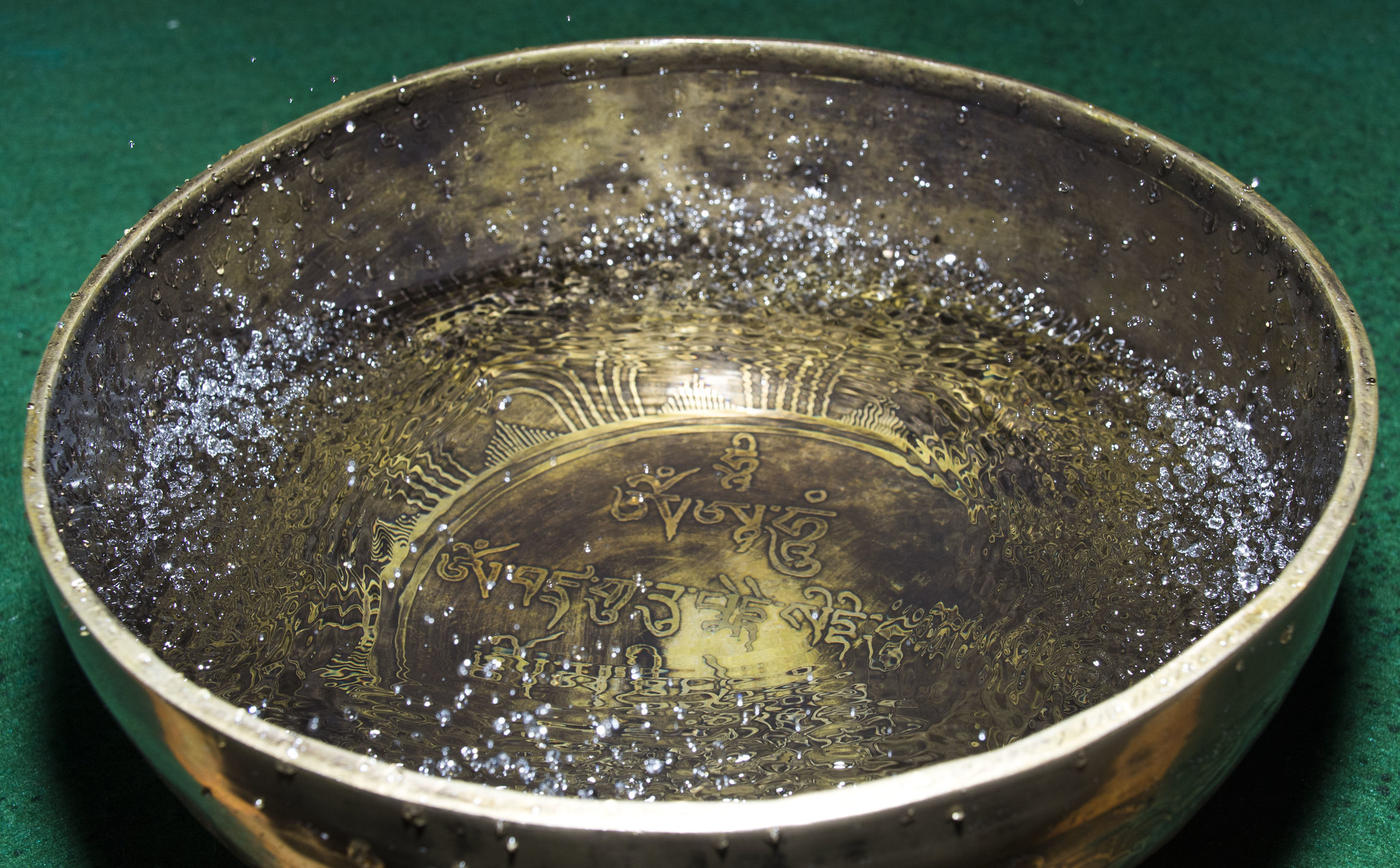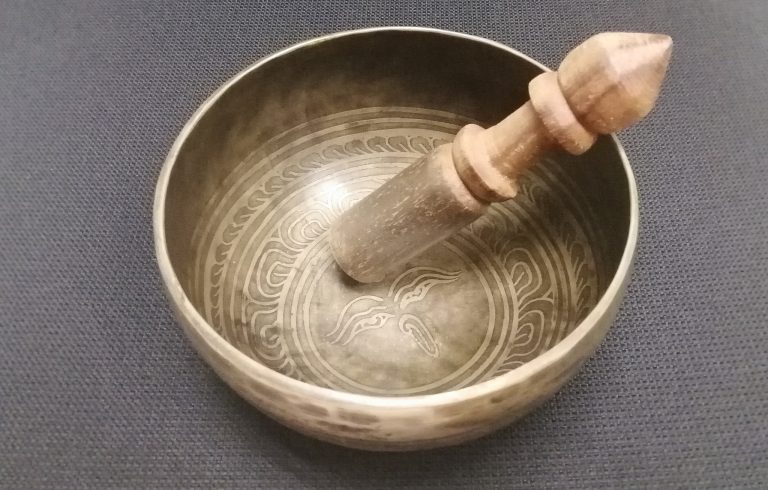A Tibetan singing bowl has the ability to calm the heart, empty the mind, and teach the Dharma, according to a tradition that was all but lost when Communism arrived to destroy culture and spirituality. Although very little is recorded of their history, aging lamas have been able to shed some light on the purpose and use of these mystical tools.
What is a Tibetan singing bowl
While they may have originally been used for begging bowls by monks in ancient times, these traditionally handmade bowls, also called standing bells, are crafted from bell metals to carry a tone, or resonance, when struck or rubbed with a mallet. The tone varies with the size and quality of the bowl, as well as, by some accounts, the amount of virtue possessed by the player.
The tone of a singing bowl is created when the friction produced by the mallet causes the metal to vibrate, in much the same way that a wine glass will sing when the rim is rubbed with a wet finger. Continuous rubbing keeps the tone alive, while touching the edge will snuff it out. If you stop playing, but do not interrupt the sound, the resonance will continue and gradually fade out.

Experiments with water have shown that the rim of the bowl is imperceptibly changing shape when played, displaying a slightly more oval shape that shifts back and forth. The water itself becomes energized, making small droplets jump off the surface. Adding water will change the tone of the bowl, and the energized water may be beneficial for both plants and people.
Success
You are now signed up for our newsletter
Success
Check your email to complete sign up
The sound vibrations are not only heard, but also felt, and many believe that singing bowls have healing properties. Oncologist and professor Mitchell Gaynor, of Weill Cornell Medical College, began using singing bowls and other forms of sound therapy for healing in the 1990s. He asserted that sound therapy reduced stress and improved the immune system, placing patients in a meditative state that promoted healing.
History and tradition of singing bowls
While only introduced to the west around 30 years ago, Tibetan singing bowls have a history of up to 5000 years. The first bowls may have been made from metals derived from meteorites, giving them a unique clarity. Today’s bowls are formed from alloys of 5, 7, 9, or even 12 metals, including copper, bronze, brass and tin, as well as the rare meteorite iron.
Much of our limited knowledge about singing bowls comes from an interview with Tibetan Lamas by musicologist Rain Gray. Gray had been studying the bowls for eight years before he obtained the interview in 1986.
As the younger monk, Lama Lobsang Molam, translated into broken English, the elder Lama Lobsang Leshe explained what he remembered about singing bowls before the temples and religious artifacts were destroyed in the Communist Party’s Cultural Revolution. Lama Lobsang Leshe was a monk at the Drepung Monastery in Tibet before he came to Nepal in 1959.
According to Leshe, the first singing bowls were limited to three. They are considered relics, and were kept at the Drepung, Narthang, and Sakya Monasteries in Tibet. The Narthang and Sakya bowls seem to have been lost, with only the Drepung relic remaining today. This bowl was said to have been used as a begging bowl by the third Buddha, who preceded Buddha Shakymuni. At that time all the monks used singing bowls for begging bowls.
Later, the treasured relics were used by Shakymuni as a tool to teach his Dharma. Many high level lamas came to listen to the sound, which was said to teach about the concept of vastness, and void, and impart the Four Noble Truths. According to legend, those with negative karma produced a lower quality tone when they played the original singing bowls, while those with positive karma produced a pure tone.
Thousands of Geshes at Drepung Monastery continue the tradition of meditating on the sound of singing bowls to this day.
The use and purpose of Tibetan singing bowls

While many beginners approach singing bowls as a relaxation tool, the actual purpose of these bowls is much more profound. According to musicalgrowth.com, the singing bowl serves five distinct functions.
Teaching
The sound and vibrations teach the listener the Dharma by way of emptiness, or the void. Buddha’s energy is transmitted to teach the Four Noble Truths, preparing the listener to enter “Shambhala,” a mythical kingdom ruled by the future Buddha.
The Four Noble Truths include:
- The Truth of Suffering, meaning that all existence is suffering.
- The Truth of Cause, meaning that our suffering is caused by ignorance, which then causes craving and illusion.
- The Truth of Extinction, meaning that there is, in Nirvana, or Enlightenment, an end to the suffering.
- The Truth of the Path, or the way in which Nirvana is achieved, namely through the Eightfold Noble Path.
Gathering
The resonance of singing bowls is said to be so powerful that even hungry ghosts from thousands of miles away can hear the sound. Those who hear the singing bowl will be moved to participate in mindfulness.
The positive energy generated by the tones will gather those needed to fight the negative forces threatening to destroy the world.
Opening
The pureness of the wooden mallet in contact with the complex metal alloy opens the mind to the Buddha’s teachings, including the Four Noble Truths. Different singing bowls are used to open specific Chakras, or energy channels.
Enlightening
Meditating on the sound of the singing bowl is said to help one achieve higher spiritual realms, eventually leading to enlightenment. Buddhism holds that there is a set of principles which guide one to enlightenment, and an end to suffering, called the Eightfold Noble Path:
- Right understanding (Samma ditthi)
- Right thought (Samma sankappa)
- Right speech (Samma vaca)
- Right action (Samma kammanta)
- Right livelihood (Samma ajiva)
- Right effort (Samma vayama)
- Right mindfulness (Samma sati)
- Right concentration (Samma samadhi)
Transforming
The sound of the singing bowl is an invitation for energy to enter the soul and speak directly to the heart, without being diluted by language. Singing bowls help bring out one’s Buddha nature and transform the ordinary with higher energy.
The future, or coming Buddha has been called “Maitreya,” which can be translated as “harmonic resonance.” This Buddha is to achieve complete enlightenment on Earth and teach the pure Dharma, saving sentient beings.
One who is fortunate enough to own a singing bowl should treasure it as a sacred tool, and treat it with proper care and respect.














